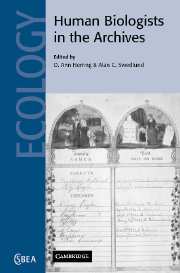 Human Biologists in the Archives
Human Biologists in the Archives Book contents
- Frontmatter
- Contents
- Contributors
- Foreword by Sydel Silverman and Michael A. Little
- Acknowledgements
- 1 Human biologists in the archives: demography, health, nutrition and genetics in historical populations
- 2 The use of archives in the study of microevolution: changing demography and epidemiology in Escazú, Costa Rica
- 3 Anthropometric data and population history
- 4 For everything there is a season: Chumash Indian births, marriages, and deaths at the Alta California missions
- 5 Children of the poor: infant mortality in the Erie County Almshouse during the mid nineteenth century
- 6 Worked to the bone: the biomechanical consequences of ‘labor therapy’ at a nineteenth century asylum
- 7 Monitored growth: anthropometrics and health history records at a private New England middle school, 1935–1960
- 8 Scarlet fever epidemics of the nineteenth century: a case of evolved pathogenic virulence?
- 9 The ecology of a health crisis: Gibraltar and the 1865 cholera epidemic
- 10 War and population composition in Åland, Finland
- 11 Infectious diseases in the historical archives: a modeling approach
- 12 Where were the women?
- 13 Malnutrition among northern peoples of Canada in the 1940s: an ecological and economic disaster
- 14 Archival research in physical anthropology
- Index
- References
10 - War and population composition in Åland, Finland
Published online by Cambridge University Press: 12 August 2009
- Frontmatter
- Contents
- Contributors
- Foreword by Sydel Silverman and Michael A. Little
- Acknowledgements
- 1 Human biologists in the archives: demography, health, nutrition and genetics in historical populations
- 2 The use of archives in the study of microevolution: changing demography and epidemiology in Escazú, Costa Rica
- 3 Anthropometric data and population history
- 4 For everything there is a season: Chumash Indian births, marriages, and deaths at the Alta California missions
- 5 Children of the poor: infant mortality in the Erie County Almshouse during the mid nineteenth century
- 6 Worked to the bone: the biomechanical consequences of ‘labor therapy’ at a nineteenth century asylum
- 7 Monitored growth: anthropometrics and health history records at a private New England middle school, 1935–1960
- 8 Scarlet fever epidemics of the nineteenth century: a case of evolved pathogenic virulence?
- 9 The ecology of a health crisis: Gibraltar and the 1865 cholera epidemic
- 10 War and population composition in Åland, Finland
- 11 Infectious diseases in the historical archives: a modeling approach
- 12 Where were the women?
- 13 Malnutrition among northern peoples of Canada in the 1940s: an ecological and economic disaster
- 14 Archival research in physical anthropology
- Index
- References
Summary
Introduction
Traditionally, anthropologists have focused their research on small populations, examining diversity and illuminating the complexity of many factors. Since an anthropological perspective is different from that of a demographer or historian, the analysis of historical archives by biological anthropologists provides new and different insights into human population dynamics. Using archival resources in studies of historical population structure and historical epidemiology will undoubtedly advance our understanding of demographic changes, the history and evolution of diseases, and the factors influencing population growth and decline. Thus, the temporal and biocultural perspective of anthropologists often uncovers intriguing relationships, contributing to our broader understanding of evolution and population change.
Historical demographers have often explained mortality patterns and demographic changes in terms of living standards and wages (Landers 1992a). A number of historical demographers are now shifting their focus, arguing that local and regional diversity in the spatial structure of populations affects the degree and intensity of exposure to infectious agents (Dobson 1992; Landers 1992b; Langford and Storey 1993). Studies now examine such things as population size and density, migration patterns, and economic and social variation within an area as major contributing factors to the spread and impact of diseases. Some researchers are now also shifting their focus from large continental populations to local and regional levels. Dobson (1992) even suggests that the term epidemiological landscapes may be appropriate to characterize the complex diversity seen in disease patterns and epidemic outbreaks.
- Type
- Chapter
- Information
- Human Biologists in the ArchivesDemography, Health, Nutrition and Genetics in Historical Populations, pp. 216 - 233Publisher: Cambridge University PressPrint publication year: 2002


